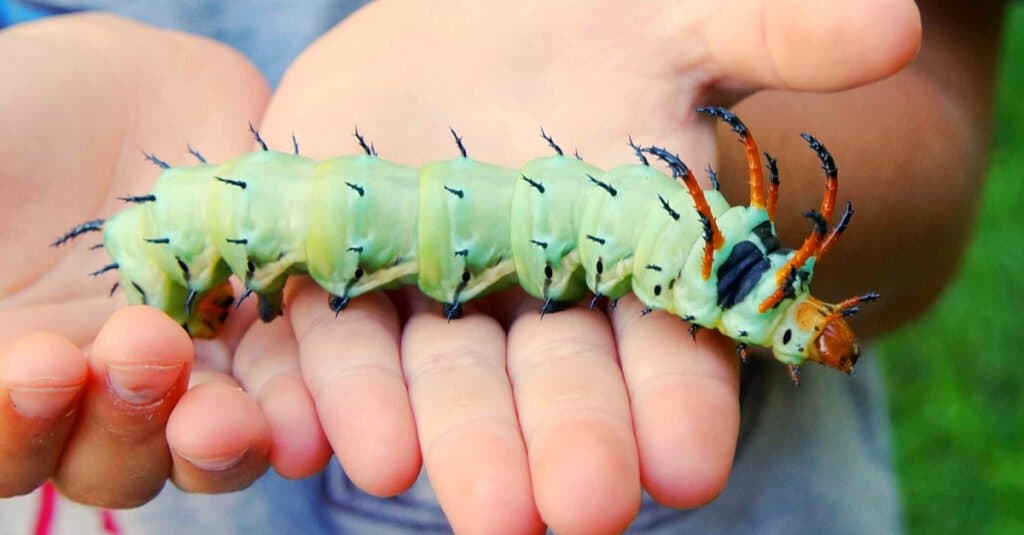There are an awful lot of giant bugs in our world, but have you ever considered just how large the largest caterpillar is? No, the largest caterpillar won’t be found in Australia, alongside the largest earthworm. Nor can it be found in Brazil alongside the largest fly. In fact, the largest caterpillar is found within the United States, specifically in eastern locations.
In this article, we will go over just how large the largest caterpillar is, especially given the fact that it’s about the size of a large hot dog! Known as the hickory horned devil, the largest caterpillar on earth becomes an even larger and more beautiful moth! While the name of this particular larva doesn’t sound the most friendly, you may be surprised by just how beautiful this hot dog-sized caterpillar can be. Let’s take a closer look now!
Meet the Hickory Horned Devil, the Largest Caterpillar

, depending on gender and the overall health of the individual.
©Matt Jeppson/Shutterstock.com
Classified as Citheronia regalis, the hickory horned devil is the largest caterpillar in the world. While it eventually becomes the royal walnut moth or regal moth depending on who you’re talking to, the hickory horned devil maintains a larval or caterpillar form for just over one month’s time.
During this time, the hickory horned devil maintains a peaceful existence, despite its threatening appearance. While it may look spiky and even potentially poisonous, this caterpillar is harmless, looking the way it does to dissuade birds or other predators from eating it. The life cycle of the hickory horned devil is especially important given the fact that these moths only produce one generation per year.
It’s important to recognize the complicated life cycles of our pollinators, even one as “small” as the hot dog-sized hickory horned devil. Not only doe this particular caterpillar only have one generation per year that needs to survive, but it also burrows in order to pupate. This is different than many other caterpillars who choose to pupate in the relative safety of vegetation and plants.
Hickory horned devils put their existence at risk when they travel to the ground in search of soft soil that they can burrow in. Given their frightening appearance, many humans consider them a threat at first glance. However, if you ever find a hickory horned devil on the ground or sidewalk, try to relocate it to a place it can descend into the soil and continue its life cycle in peace!
How Large is the Average Hickory Horned Devil?

The appearance of the hickory horned devil would hopefully stop you from putting mustard on it.
©Matt Jeppson/Shutterstock.com
The hickory horned devil caterpillar averages anywhere from 12-15 centimeters long, depending on gender and the overall health of the individual. Given the fact that the average Oscar Mayer wiener is just over 15 centimeters, it would likely be easy to mistake a hickory horned devil for a hot dog! Well, to an extent…
The appearance of the hickory horned devil would hopefully stop you from putting mustard on it. With a blueish-green hue and prickly-looking orange horns on both its head and abdominal segments, this caterpillar does its best to avoid being eaten by anyone, hot dog bun or otherwise!
Where Can You Find Hickory Horned Devils?
You can only find hickory horned devils in the United States, particularly the easternmost portions of it. Located as far north as New Jersey and as far south as Florida, the hickory horned devil is a fairly common sight in southern states. If you haven’t seen a hickory horned devil in person, perhaps you have seen what it becomes instead: the regal moth!
What Does the Hickory Horned Devil Become?

While the regal moth may not be the largest, it still maintains nearly 6 inches of wingspan!
©Betty Shelton/Shutterstock.com
Also known as the royal walnut moth for its preferred egg-laying location, the regal moth is even more beautiful than its larval stage. The wingspan of the regal moth is similar to its caterpillar form, reaching an average of 10-15 centimeters when fully grown. Often a dusty gray and orange color, the regal moth has a soft appearance, complete with beige or yellow spots across its wings.
You can typically find regal moths in flight during the summertime, particularly the months of June through August. The adult moths spend their limited lifespan mating and laying eggs, incapable of eating due to the vestigial existence of their mouths. Therefore, the beautiful but ephemeral regal moth only lives less than ten days on this planet.
Other Types of Large Caterpillars

You can typically find regal moths in flight during the summertime, particularly the months of June through August.
©iStock.com/ErikaMitchell
While the hickory horned devil is indeed one of the largest caterpillars on earth, there are a few more fascinating specimens on our planet. Here are a few other types of large caterpillars and roughly how large they get on average:
- Cecropia caterpillar (¾ inch diameter!)
- Luna caterpillar (4 inches long!)
- Polyphemus caterpillar (4 inches long and quite wide!)
- Tobacco hornworm (3-4 inches long!)
Up Next:
- The 12 Largest Caterpillars in the World
- The 10 Largest Moths in the World
- Caterpillar vs Centipede: What Are the Differences?
The photo featured at the top of this post is © Matt Jeppson/Shutterstock.com
Sources
- University of Florida, Available here: https://edis.ifas.ufl.edu/publication/IN209
Thank you for reading! Have some feedback for us? Contact the AZ Animals editorial team.






